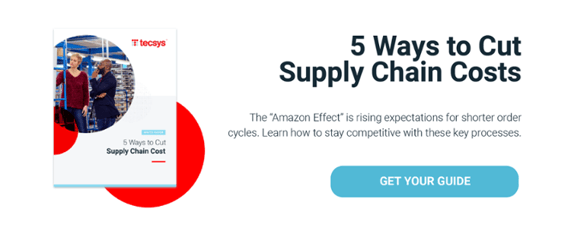The Trials and Tribulations of Warehouse Returns Management

Ask anyone in your warehouse how well they like to handle returns, and you’ll likely hear a sigh or groan in response. That’s because the warehouse returns management process, with its time and space requirements and excess inventory management, is a sizeable hassle
for most distributors. Returns are not a tidy process
to manage the way regular inbound and outbound activities are. Sometimes items are broken or in a box with other unrelated SKUs. Sometimes they’re out of stock or no longer sold, meaning there may be a subsequent return to a vendor. There’s also extra processing required to determine what to do with unusable products, like dispose of it or request a vendor return material authorization (RMA). The list goes on. The only thing predictable about returns is that they’re unpredictable. That said, there are ways to make life easier on the returns front. But first, let’s look at how this return management process typically works.
Discover other ways to trim expenses in your warehouse with this valuable guide:
5 Ways to Start Cutting Supply Chain Costs
Customer Returns Management
Warehouses everywhere deal with customer returns that are sent back for any number of reasons. Some products are damaged or expired, some aren’t what was ordered, and others just didn’t meet expectations on a variety of fronts (no longer needed, size, color, etc.). Several steps have to happen when these goods arrive in your warehouse:
-
- Receipt into the hold area: Customer returns are often received into a hold area where they’re separated from other receipts to minimize confusion.
- Inspection and evaluation: The receiving team has the daunting task of opening each container and visually inspecting the contents to determine what to do with each item. This is a highly manual, time-consuming process with a lot of judgement calls about what should happen with each product.
- Items to be scrapped: Some returned products simply have to be scrapped, particularly when dealing with refrigerated items where there may have been out-of-tolerance temperature fluctuations during transit that could impact safety. Penny items are often discarded because they’re not worth the time required to put them back into stock. Also, for guaranteed sales programs, a rep from your vendor may have to come to the DC to determine whether something is authorized to be scrapped. And sometimes DCs even receive items that they never sold in the first place, which ultimately head for the trash. For example, you distribute electrical supplies, but your customer sends you a canoe with his returned goods. What do you do with that?
- Items to be put away and resold: If products are in good condition, they can either be returned to stock to become available to fulfill another order, or they may be kept in a holding area until more of the same item arrives and can be grouped into a case or palette for eventual put-away. Unfortunately, this often means there are random products cluttering up your returns area, and employees may not know whether they’re available for picking, ready for the shelf, etc.
Returns in the pharmacy world require extra layers of oversight as unused drugs on hospital floors (wards) often have to be returned to the main pharmacy if a patient is discharged early or doesn’t require the medication—or if product is expired. There are temperature control considerations as well as strict requirements on how unused doses should be disposed of or introduced back into stock.
Outgoing Vendor Returns Management
The reverse process for warehouse returns management involves vendors and is an outbound function. This has all the hallmarks of a traditional pick/pack/ship workflow but involves extra legwork on the front end to set up the return. Usually, an associate will contact the vendor for an RMA allowing the products to be shipped back to their warehouse. This can happen for seasonal items left over as part of a guaranteed sales plan, for products that arrived damaged, or for excess products nearing expiration that the vendor could resell via a different channel.
The Keys to Success
Ideally, your returns process should be a streamlined warehouse management operation, so merchandise is sent to your DC and you know exactly what’s in the box without having to sort and visually inspect items before putting them away. Even if this isn’t always possible, below are a few tips on making returns less painful.
Customer Returns Management: Best Practices
- Define a space in your DC that is designated specifically for returns—one that is separate from your receiving dock! Although DC space is often at a premium, segregating this task from the rest of your operations reduces confusion and gives associates the space they need to triage products.
- Make sure you have a fast and easy workflow established to scan customer returns and receive them into the DC quickly, especially if you have frequent occurrences of the same items coming back time after time. This way you can group these items and release them back to inventory together in the same container, reducing the time spent on put-away. This works well for high-value items that should be protected in a separate spot.
- Educate associates dealing with returns on how to determine which products are sellable and should be returned to stock, and which should be scrapped. As customer returns can take a lot of time for evaluation, the more efficient your team can become in dealing with one-off situations, the better.
- Don’t let returns pile up in your warehouse. It will take more time to sort through the piles of inventory than processing it as it comes in. Yes, this can be disruptive, but if it can be processed every day, it will allow you to return sellable inventory to stock and destroy and discard unusable inventory faster.
Vendor Returns: Best Practices
- For vendor returns, a separate area should be set aside to hold these products once they’ve been taken from stock, so they’re not accidentally picked for an order. This is critical for damaged or expired items that should be taken out of circulation. Some DCs have a common area established for damaged goods that associates know to avoid when picking.
- Evaluate your outbound workflow to ensure you have enabled efficient warehouse picking, packing, and shipping and inventory management. You’ll likely have to allocate the appropriate inventory based on hold codes as you prepare the shipment for the vendor.
Interested in learning more?
Related blog post: The Future of Warehouse Management Systems (WMS) Must Support Complex Warehouse Requirements for a New Era of Buyers



